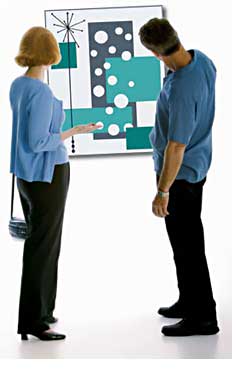Wall Art: The House Awakens
 The artistic austerity of the Eichler homes creates both a challenge and an opportunity for owners when they look to personalize their own home interiors. And selecting and displaying art that harmonizes with the Eichler design's modern aesthetic is surely part of this process.
The artistic austerity of the Eichler homes creates both a challenge and an opportunity for owners when they look to personalize their own home interiors. And selecting and displaying art that harmonizes with the Eichler design's modern aesthetic is surely part of this process.
But is there such a thing as Eichler-compatible art, and if so, how is it defined? Ask most Eichler owners if it exists, and you will hear: "Absolutely!" Ask them to define it, and responses become more varied: "You know it when you see it," or "I can tell you what doesn't work," or "Look back at the classic modernism of the 1950s and '60s," or simply "Come to my house and I'll show you."
Stanford art professor and Eichler owner Matt Kahn began his decade as Eichler Homes' aesthetic consultant in 1954 with the ambitious Eichler art experiment 'Art About the House.' Reaching the pages of Life magazine, this event brought together a Palo Alto Eichler home, a potpourri of art objects, and a throng of curious visitors.
Today, after a 50-year career immersed in art, Kahn still has much to say about the meaning of Eichler architecture and its relationship to filling it with furnishings and art. "I think one of the great achievements of the Eichler expression—maybe not one that was sought specifically—is that with so many houses so much alike, and so understated or simple in structure, they are very permissive," Kahn points out. "Maybe they instigate you to do things with the house that you might not otherwise think to do if it were assertive in style. While you don't fool around with a Frank Lloyd Wright house because of its assertiveness, you sure can with an Eichler home. And I think you should."
San Jose Eichler owner and real estate agent Loni Nagwani helps her clients prepare and stage their homes for sale, and in that capacity she is oftentimes responsible for selecting and exhibiting art for her clients. Nagwani, who has a keen eye for naturally integrating art—even the unusual—into her own Eichler, has found that above all else one should keep it simple. "You don't need a lot of things," Nagwani says. "In fact, one large, clean, modern piece—even a plant or sculpture—can have wonderful impact. And if you have mahogany walls, you can even leave one of them empty. I would rather have the wall bare than put things that don't work on it or just fill it because it's there."
But what is art and why does it seem to capture so much of our imagination? Defining art is a little like trying to describe why a summer day may inspire the same awe as a cold winter one after the first snow. One Bay Area Eichler owner and art collector defines it this way: "Art is a representation of a mental image put on canvas. It makes you feel good when you look at it." Art can be categorized by the media used (paintings in acrylic, oil or water color; line drawings; photographs; collage; weaving; or sculpture); by subject matter (people, places, still life, abstraction); or by some other unifying theme, such as family photos, our children's finger-painting, or pieces collected during family vacations or world travels. Many things can function as art—but most of all, art is personal. It allows us to surround the space we live in by things that make us feel good, that remind us of fond memories of the past, or that set the stage or make a statement for guests as they enter our home.

Art that is abstract seems to work especially well in Eichlers and the art world has many '-ism' terms for the various schools of non-realistic art. These include surrealism, cubism, impressionism, expressionism, and neoplasticism. Whatever you call it, art that is one or two or three steps away from realism harmonizes well with the simplicity of the Eichler design. Classic masters such as Picasso and Matisse are popular starting points—Picasso for his cubism, and Matisse for his impressionistic simplicity and vision.
But Kahn prefers originals to prints. "If you have originals of these artists, there is no question," Kahn says. "But I would rather see perhaps a lesser piece that is an original than prints. There are an awful lot of major works by minor people, just as there are minor works by major people. Maybe at the residential level, those are the things we should be looking for."




